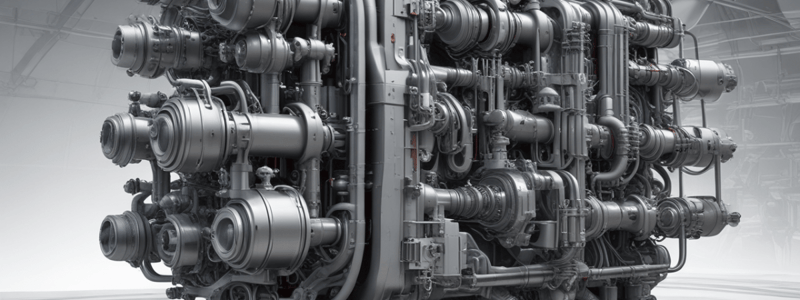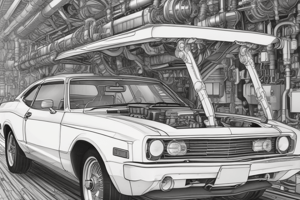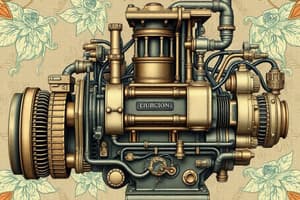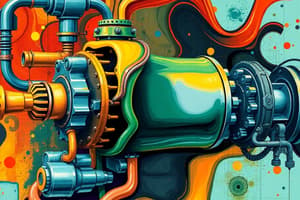Podcast
Questions and Answers
What is a disadvantage of the mist lubrication system?
What is a disadvantage of the mist lubrication system?
- It requires a separate oil pump and filter.
- It causes heavy exhaust and forms deposits on the piston crown. (correct)
- It is not suitable for four-stroke engines.
- It is more expensive than wet-sump lubrication systems.
What type of lubrication system is commonly used in small, stationary four-stroke engines?
What type of lubrication system is commonly used in small, stationary four-stroke engines?
- Pressure lubrication system
- Mist lubrication system
- Splash and pressure system
- Splash lubrication system (correct)
Why is the mist lubrication system not popular among lubrication systems?
Why is the mist lubrication system not popular among lubrication systems?
- It is too complex and requires frequent maintenance.
- It has several serious disadvantages, including oil contamination and corrosion of bearings. (correct)
- It is more expensive than other lubrication systems.
- It is only suitable for two-stroke engines.
What is a characteristic of solid lubricants?
What is a characteristic of solid lubricants?
What is the purpose of the oil pan or sump in the wet-sump lubrication system?
What is the purpose of the oil pan or sump in the wet-sump lubrication system?
What is the primary purpose of the engine cooling system?
What is the primary purpose of the engine cooling system?
What is the main function of lubricants in reducing friction?
What is the main function of lubricants in reducing friction?
Which type of lubricant is environmentally friendly and designed to break down more easily in the environment?
Which type of lubricant is environmentally friendly and designed to break down more easily in the environment?
What is the primary advantage of using synthetic oils?
What is the primary advantage of using synthetic oils?
What is the purpose of greases in lubrication?
What is the purpose of greases in lubrication?
What is the primary function of the scoop in the big end bearing of the connecting rod?
What is the primary function of the scoop in the big end bearing of the connecting rod?
Which of the following lubrication systems is NOT used in high-speed engines?
Which of the following lubrication systems is NOT used in high-speed engines?
What is the primary function of the Engine Control Unit (ECU) in a fuel injection system?
What is the primary function of the Engine Control Unit (ECU) in a fuel injection system?
What is the main difference between Port Fuel Injection (PFI) and Direct Injection (DI) systems?
What is the main difference between Port Fuel Injection (PFI) and Direct Injection (DI) systems?
What is the purpose of the fuel filters in a fuel supply system?
What is the purpose of the fuel filters in a fuel supply system?
What is the primary function of the fuel pressure regulator in a fuel system?
What is the primary function of the fuel pressure regulator in a fuel system?
What is the main advantage of Multi-Point Fuel Injection (M.P.F.I.) systems over carbureted engines?
What is the main advantage of Multi-Point Fuel Injection (M.P.F.I.) systems over carbureted engines?
What component is responsible for distributing pressurized fuel to each injector in a Multi-Point Fuel Injection (M.P.F.I.) system?
What component is responsible for distributing pressurized fuel to each injector in a Multi-Point Fuel Injection (M.P.F.I.) system?
What type of fuel injection system is characterized by fuel injectors being timed to spray fuel sequentially with the intake valve opening?
What type of fuel injection system is characterized by fuel injectors being timed to spray fuel sequentially with the intake valve opening?
What is the primary function of the Engine Control Unit (ECU) in a Multi-Point Fuel Injection (M.P.F.I.) system?
What is the primary function of the Engine Control Unit (ECU) in a Multi-Point Fuel Injection (M.P.F.I.) system?
What is the primary purpose of a bypass recirculation system in a cooling system?
What is the primary purpose of a bypass recirculation system in a cooling system?
What is the function of the thermostat in a liquid cooling system?
What is the function of the thermostat in a liquid cooling system?
What is the primary purpose of the bypass recirculation system in industrial engines?
What is the primary purpose of the bypass recirculation system in industrial engines?
What is the advantage of a liquid cooling system over an air cooling system?
What is the advantage of a liquid cooling system over an air cooling system?
What is the primary reason for using antifreeze mixtures in cooling systems?
What is the primary reason for using antifreeze mixtures in cooling systems?
What is a characteristic of an ideal antifreeze solution?
What is a characteristic of an ideal antifreeze solution?
What is the purpose of the radiator in a liquid cooling system?
What is the purpose of the radiator in a liquid cooling system?
What is a benefit of using a bypass recirculation system in a cooling system?
What is a benefit of using a bypass recirculation system in a cooling system?
What is a common antifreeze solution used in cooling systems?
What is a common antifreeze solution used in cooling systems?
What is an advantage of using water cooling systems in engines?
What is an advantage of using water cooling systems in engines?
What is a disadvantage of using water cooling systems in engines?
What is a disadvantage of using water cooling systems in engines?
What is the purpose of the water pump in a water cooling system?
What is the purpose of the water pump in a water cooling system?
What happens if the water cooling system fails?
What happens if the water cooling system fails?
Why is the water cooling system costlier than air cooling systems?
Why is the water cooling system costlier than air cooling systems?
What is an advantage of using water cooling systems in moving vehicles?
What is an advantage of using water cooling systems in moving vehicles?
What is the primary function of the common rail in a C.R.D.I. system?
What is the primary function of the common rail in a C.R.D.I. system?
Which of the following is NOT a benefit of the C.R.D.I. system?
Which of the following is NOT a benefit of the C.R.D.I. system?
What is the primary purpose of the cooling system in an automobile?
What is the primary purpose of the cooling system in an automobile?
What is the primary advantage of direct fuel injection in a C.R.D.I. system?
What is the primary advantage of direct fuel injection in a C.R.D.I. system?
What is the function of the Engine Control Unit (ECU) in a C.R.D.I. system?
What is the function of the Engine Control Unit (ECU) in a C.R.D.I. system?
Flashcards are hidden until you start studying
Study Notes
Lubrication System
- Purpose of Lubrication System:
- Reduces friction between moving parts
- Minimizes wear and tear on components
- Absorbs and dissipates heat generated by friction
- Acts as a sealant to prevent contaminants from entering the system
- Types of Lubricants:
- Mineral Oils: most common, derived from crude oil, offering good lubrication properties and cost-effectiveness
- Synthetic Oils: superior performance in extreme temperatures and conditions, longer-lasting lubrication, and better resistance to oxidation
- Greases: semi-solid material used where conventional oils wouldn't stay in place or provide adequate lubrication
- Biodegradable Oils: environmentally friendly lubricants designed to break down more easily
- Solid Lubricants: used in situations where conventional lubricants may not be suitable or practical
- Application Methods:
- Splash Lubrication: parts are submerged in a pool of lubricant and splashed onto other parts
- Pressure Lubrication: oil is pumped under pressure to various points needing lubrication
- Manual Lubrication: lubricant is manually applied to specific parts
- Mist Lubrication: oil is sprayed as a mist into a stream of air, carrying it to the parts needing lubrication
Types of Lubrication Systems
- Mist Lubrication System:
- Simple system where a small quantity of lubricating oil is mixed with fuel
- Preferred in two-stroke engines where crank base lubrication is not required
- Disadvantages: oil combustion, corrosion of bearings, lack of control over lubricant supply, and no control over lubricant quantity
- Wet-Sump Lubrication System:
- Oil supply, storage tank, and oil cooler are combined in the crank case
- Three varieties: Splash Lubrication System, Splash and Pressure System, and Pressurized Lubrication System
- Dry-Sump Lubrication System:
- Oil supply is carried from an external tank
- Used in heavy-duty engines
Fuel Supply System
- Types of Fuel Supply Systems:
- Carburettor System: historically common in older vehicles, mixes air and fuel before delivering it to the engine's cylinders
- Fuel Injection System: modern vehicles use fuel injection systems, where fuel is injected directly into the combustion chamber or intake manifold
- Components of a Fuel Supply System:
- Fuel Tank: stores the fuel and includes mechanisms for venting and refueling
- Fuel Pump: moves fuel from the tank to the engine at the required pressure
- Fuel Filters: removes contaminants and impurities from the fuel
- Fuel Lines and Hoses: transports fuel from the tank to the engine and between various components of the fuel system
- Fuel Pressure Regulator: maintains a consistent fuel pressure in the system
- Fuel Injectors: injects precise amounts of fuel into the combustion chamber or intake manifold
- Sensors: monitor various parameters such as fuel pressure, air-fuel ratio, and engine temperature to optimize fuel delivery and combustion efficiency
M.P.F.I. (Multi-Point Fuel Injection)
- Description: fuel injectors are located at each intake port of the engine cylinder head, where they spray fuel directly into the intake manifold or just upstream of the intake valve
- Components:
- Fuel Injectors: each cylinder has its own injector, which is controlled electronically to precisely meter and spray the correct amount of fuel
- Fuel Rail: distributes pressurized fuel to each injector from the fuel pump
- Fuel Pressure Regulator: maintains consistent fuel pressure within the system
- Sensors: monitor engine parameters such as engine speed, throttle position, intake air temperature, and oxygen levels to adjust fuel delivery for optimal combustion
- Operation:
- The Engine Control Unit (ECU) processes input from various sensors to determine the amount of fuel needed based on operating conditions
- The ECU then controls each injector's opening and closing times to deliver the precise amount of fuel required for efficient combustion
- Advantages:
- Precision: allows for precise control of the air-fuel mixture for each cylinder, optimizing combustion efficiency and power output
- Fuel Efficiency: delivers the right amount of fuel at the right time, improving fuel efficiency compared to carbureted engines
- Emissions: helps in reducing harmful emissions by ensuring more complete combustion
- Performance: provides better throttle response and smoother operation across various driving conditions
C.R.D.I. (Common Rail Direct Injection)
-
Description: an advanced fuel injection technology used primarily in diesel engines, where fuel is injected directly into the combustion chamber at high pressure
-
Components:
- Fuel Pump: maintains high pressure in the common rail
- Injectors: each cylinder has its own injector, which is electronically controlled to inject fuel into the combustion chamber at the right moment
- Common Rail: acts as a reservoir and pressure accumulator for the fuel before it is injected into the cylinders
- Engine Control Unit (ECU): controls the timing and duration of fuel injection based on inputs from various sensors
- Pressure Regulator: ensures consistent fuel pressure in the common rail system
-
Advantages:
- Fuel Efficiency: allows for precise control of fuel injection, optimizing combustion efficiency and reducing fuel consumption
- Power and Performance: improves engine power output and torque by ensuring more complete combustion of fuel
- Emissions: reduces exhaust emissions, including particulate matter (PM) and nitrogen oxides (NOx), meeting stringent emission standards
- Smoothness: provides smoother engine operation, reduced noise, and vibration compared to older diesel engines### Thermostat and Bypass System
-
The thermostat regulates coolant flow based on engine temperature, opening or closing to direct coolant flow through the bypass or radiator.
-
During cold starts, the thermostat may direct coolant through the bypass path to warm up the engine more quickly.
-
As the engine warms up, the thermostat gradually opens, allowing more coolant flow through the radiator to control temperature.
Operation of Bypass System
- In some systems, the bypass recirculation system is used to manage coolant flow under specific load or temperature conditions to optimize engine performance and efficiency.
Benefits of Bypass System
- Faster warm-up: Helps engines reach operating temperature more quickly, reducing cold-start wear and emissions.
- Temperature regulation: Ensures the engine operates within an optimal temperature range, improving fuel efficiency and reducing emissions.
- Controlled cooling: Provides flexibility in managing coolant flow based on engine load and operating conditions, enhancing overall system efficiency.
Applications of Bypass System
- Bypass recirculation systems are commonly found in modern automotive engines, especially those equipped with liquid cooling systems.
- They are also used in industrial engines, generators, and other heavy-duty applications where precise temperature control and efficiency are critical.
Antifreeze Mixture
- Antifreeze mixtures are added to cooling water to prevent freezing and cracking in cold climates.
- Ideal antifreeze solutions should dissolve in water easily, not evaporate, not deposit foreign matter, not have harmful effects, be cheap, and not corrode the system.
Types of Antifreeze Solutions
- Methyl, ethyl, and isopropyl alcohols.
- Solutions of alcohol and water.
- Ethylene Glycol.
- Solutions of water and Ethylene Glycol.
- Glycerin along with water.
Advantages of Water Cooling System
- Uniform cooling of cylinder, cylinder head, and valves.
- Improves specific fuel consumption of engine.
- Allows for engine placement away from the front end of a moving vehicle.
- Reduces engine noise.
Disadvantages of Water Cooling System
- Depends on the supply of water.
- Water pump absorbs considerable power.
- Failure of the system can result in severe engine damage.
- Costlier with more parts, requiring more maintenance and care.
Studying That Suits You
Use AI to generate personalized quizzes and flashcards to suit your learning preferences.





